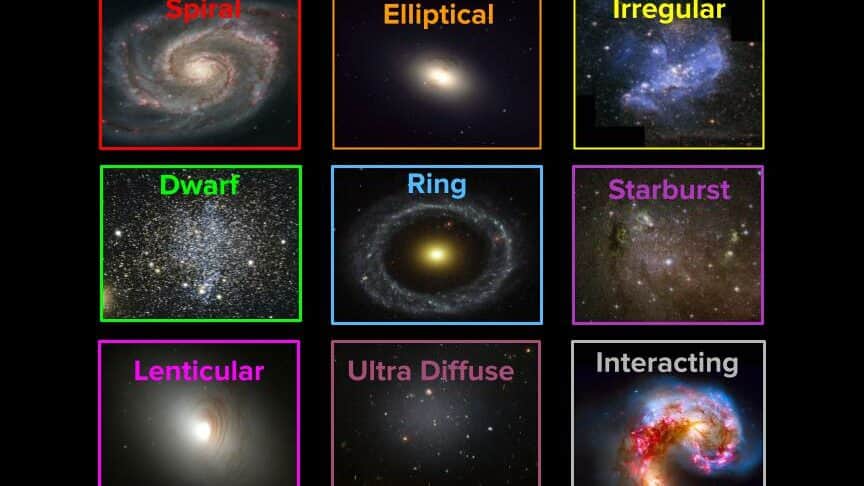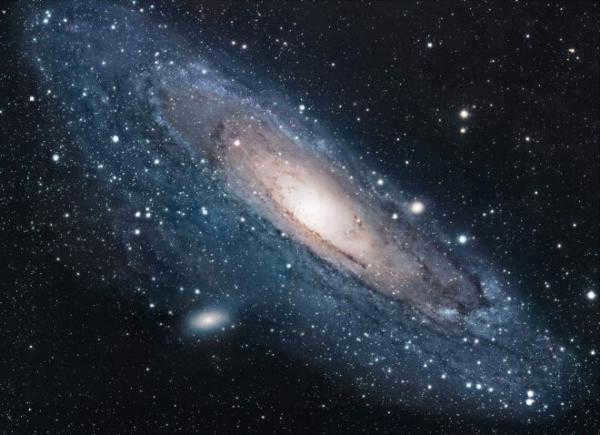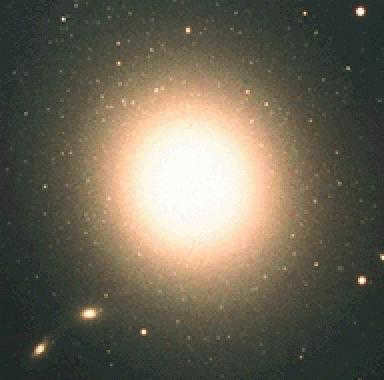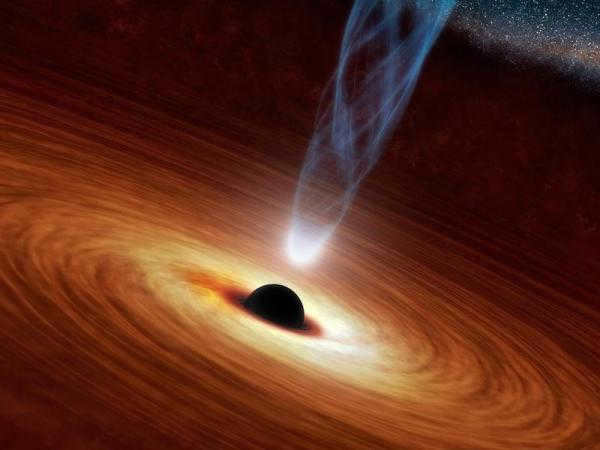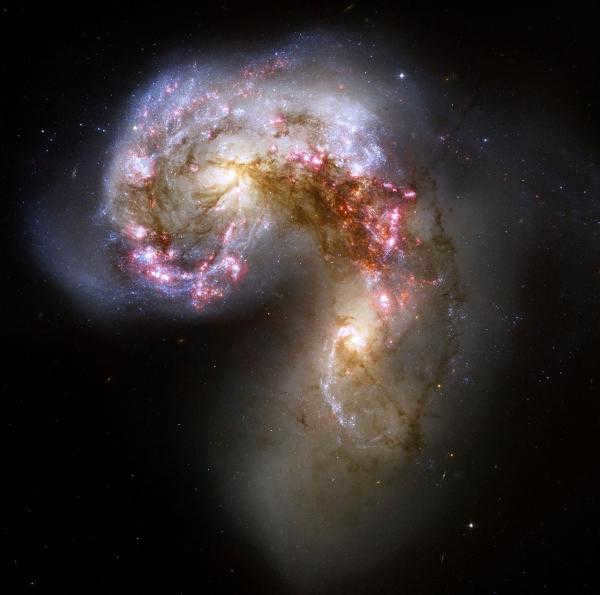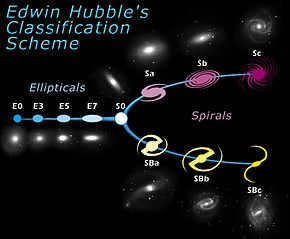
A method for categorizing galaxies according to their visual characteristics is a tuning fork-style diagram that represents the Hubble sequence.
Astronomers utilize a morphological classification system to group galaxies based on their appearance. There are multiple schemes available for classifying galaxies based on their morphology, with the most well-known being the Hubble sequence, which was initially developed by Edwin Hubble and later expanded by Gerard de Vaucouleurs and Allan Sandidge. However, contemporary classification and morphological analysis of galaxies primarily rely on computational techniques and physical morphology.
Hubble classification
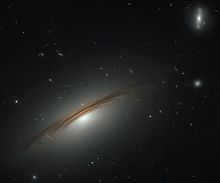
The S0 / Sa galaxy UGC 12591 is classified as a spiral galaxy.
Edwin Hubble invented the Hubble sequence in 1926 as a morphological classification scheme for galaxies. It is commonly known as the “Hubble cameraton” due to its traditional representation. The Hubble diagram originally categorized galaxies into three general classes based on their appearance (on photographic plates):
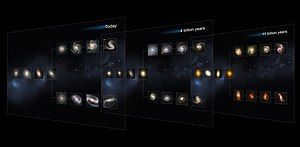
- Galaxies that do not exist in any class are nonexistent. They do not have a smooth featureless light distribution and do not appear as ellipses in images. They are not denoted by the letter “E” followed by an integer n denoting the degree of their ellipticity on the sky. The specific ellipticity rating does not depend on the ratio of the major (a) to the minor axis (b), thus:
E does not equal 10 × (1 – ba) > \ right)>.
- Galaxies that consist of a flattened disk in which stars form a spiral structure (usually double-armed) and a central concentration of stars known as a balge, which does not look similar to an elliptical galaxy, are spiral galaxies. They are not denoted by the symbol “S”. About half of all spirals do not have a rod-shaped structure branching away from the central bulge. These non-jumper spirals are not labeled with the symbol “SB”.
- Lenticular galaxies (S0) are characterized by a prominent central bulge encircled by an elongated disk-like structure. However, unlike spiral galaxies, the disks of lenticular galaxies lack spiral structure and do not exhibit significant star formation.
Hubble sequence has been used to classify galaxies throughout cosmic history.
These general categories can be expanded to encompass more intricate variations in appearance and include other galaxy types, such as irregular galaxies that lack distinct regular structure (whether disk-shaped or ellipsoidal).
The Hubble sequence is frequently depicted as a bifurcation with elliptical ends on the left (ellipticity increasing from left to right), while spirals with and without junctions form two parallel branches of the bifurcation. Lenticular galaxies are positioned at the point where the two branches meet the “handle,” between elliptical galaxies and spirals.
Currently, the Hubble sequence serves as the most widely employed system for categorizing galaxies, both in professional astronomical research settings and in amateur astronomy. However, in June 2019, citizen scientists participating in Galaxy Zoo reported that the conventional Hubble classification, particularly for spiral galaxies, lacks support and may require an update.
De Vaucouleurs system
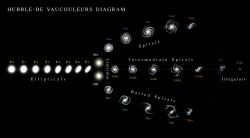 Diagram illustrating the morphology of Hubble de Vaucouleur galaxies
Diagram illustrating the morphology of Hubble de Vaucouleur galaxies 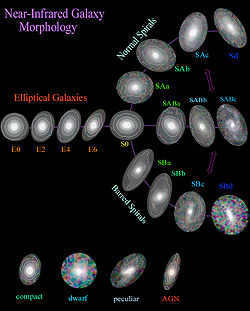
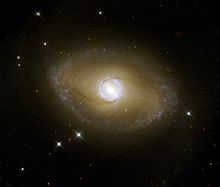 NGC 6782 is a spiral galaxy classified as SB (r) 0 / a, featuring three rings of varying radii and a central column.
NGC 6782 is a spiral galaxy classified as SB (r) 0 / a, featuring three rings of varying radii and a central column. 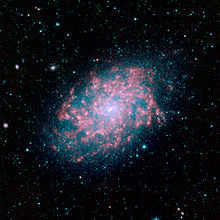 NGC 7793 is a spiral galaxy classified as SA (s) d.
NGC 7793 is a spiral galaxy classified as SA (s) d. 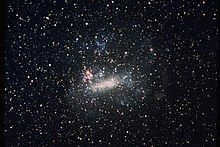 The Large Magellanic Cloud is classified as a SBm type galaxy.
The Large Magellanic Cloud is classified as a SBm type galaxy.
The de Vaucouleur system, developed by Gerard de Vaucouleur in 1959, is an extension of the Hubble sequence for classifying galaxies. De Vaucouleur believed that Hubble’s classification, which focused on the density of spiral arms and the presence or absence of a junction, was inadequate in describing the full range of galaxy morphologies. He argued that additional structural components, such as rings and lenses, needed to be considered.
The de Vaucouleurs system builds upon Hubble’s division of galaxies into ellipticals, lenticulars, spirals, and irregular galaxies. However, it introduces a more complex classification for spiral galaxies, based on three morphological characteristics.
- Galaxies are classified based on the presence or absence of a nuclear bar. De Vaucouleur introduced the SA designation for spiral galaxies without a bar, complementing Hubble’s use of SB for spirals with a bar. An intermediate class, SAB, is used for spirals with faint interlacing. Lenticular galaxies are also classified as either SA0 or SB0, with S0 reserved for galaxies where the presence of a bar cannot be determined (usually due to an edge-on line-of-sight).
- Galaxies are categorized into those with ring structures (denoted as “(r)”) and those without rings (denoted as “(s)”). Transitional galaxies are designated by the symbol (rs).
- Spiral arms. Spiral galaxies are classified primarily based on the density of their spiral arms, as in Hubble’s original scheme. The de Vaucouleur scheme expands on this and includes additional classes of spirals:
- Sd (SBd) – These galaxies have diffuse broken arms composed of individual star clusters and nebulae, and a very weak central bulge.
- Sm (SBm) – These galaxies have irregular shapes and no bulge component.
- Im – These galaxies are very irregular.
The different components of the classification scheme are combined, in the order in which they are listed, to provide a complete classification for a galaxy. For example, a spiral galaxy with a weak junction, loosely twisted arms, and a ring would be labeled SAB (r) c.
From a visual standpoint, the de Vaucouleur system can be imagined as a three-dimensional rendition of the Hubble chamberlain, with a dimension of spirality on the x-axis, a dimension of lattice on the y-axis, and a dimension of ring-shaped variety on the z-axis.
Hubble’s numerical dimension
In his scheme, de Vaucouleur also assigned numerical values to each category of galaxies. The values of the Hubble numerical dimension T range from -6 to +10, with negative numbers representing early-type galaxies (elliptical and lenticular) and positive numbers representing late-type galaxies (spirals and irregular shapes). Therefore, as a general guideline, lower T values indicate a higher proportion of the overall stellar mass contained in a spheroid/bulge compared to a disk. An approximate representation of the ratio of spheroids to total stellar mass (M B/MT) and Hubble dimension is M B/MT= (10-T) / 256 based on local galaxies.
Elliptical galaxies are categorized into three stages: compact ellipticals (cE), normal ellipticals (E), and late-type (E). Lenticels are also classified into early (S), intermediate (S), and late (S) types. Irregular galaxies can be either magellanic irregular (T = 10) or “compact” (T = 11).
| -6 | -5 | -4 | -3 | -2 | -1 | 0 | 1 | 2 | 3 | 4 | 5 | 6 | 7 | 8 | 9 | 10 | 11 |
| cE | E | S0 | S0 / a | Sa | Sab | Sb | Sbc | Sc | Scd | Sd | Sdm | Sm | Im | ||||
| E | S0 | S0 / a | Sa | Sa-b | Sb | Sb-c | Sc | Sc-Irr | Irr I | ||||||||
The utilization of numerical stages enables quantitative examinations of galaxy morphology.
Yerkes (or Morgan) scheme
The Yerkes scheme was designed by American astronomer William Wilson Morgan. Alongside Philip Keenan, Morgan also created the MC system for categorizing stars based on their spectra. The Yerkes scheme employs the spectra of stars within a galaxy; their shape, both actual and apparent; and the level of central concentration in order to classify galaxies.
| a | Distinguished stars A |
| af | Distinguished stars A – F |
| f | Exceptional stars F |
| fg | Exceptional F – G stars |
| g | Exceptional stars G |
| gk | Exceptional stars G – K |
| k | Distinguished stars K |
| B | Spiral with jumper |
| D | Rotational symmetry without a pronounced spiral or elliptical structure |
| E | Elliptical |
| Ep | Elliptical with dust absorption |
| I | Irregular |
| L | Low surface brightness |
| N | Small bright nucleus |
| S | Spiral |
For instance, the Andromeda Galaxy is classified as kS5.
Related Articles
References
- ^ “A Fascinating Galactic Hybrid”. www.spacetelescope.org. Accessed on February 27, 2017.
- ^ Hubble, E. P. (1926). “Extragalactic Nebulae”. Contributions of the Mount Wilson Observatory/Carnegie Institution of Washington. 324: 1-49. Bibcode: 1926CMWCI.324.1H.
- ^ Hubble, E. P. (1936). The world of nebulae. New Haven: Yale University Press. LCCN36018182.
- ^ [email#160;protected] “Hubble’s Chamberlain – Categorization of Galaxies”. www.spacetelescope.org. Accessed on February 6, 2019.
- ^ Binney, James (1998). Galactic astrophysics. Princeton: Princeton University Press. ISBN 978-0-691-02565-0.
- ^ “Elliptical galaxy”. COSMOS – SAO Encyclopedia of Astronomy. Accessed on September 19, 2020.
- “Hubble sequence – Astronoo”. www.astronoo.com. Retrieved February 6, 2019.
- “Lenticular galaxies”. cas.sdss.org. Checked February 6, 2019.
- “Hubble investigates origin of modern galaxies”. ESA / Hubble press release. Retrieved August 20, 2013.
- “Galaxies”. www.jb.man.ac.uk. Retrieved February 6, 2019.
- Iafrate, G. “Hubble’s LETTERS” (PDF). uni-heidelberg.de. Checked February 6, 2019.
- Royal Astronomical Society (June 11, 2019). “Citizen scientists reconfigure Hubble’s classification of galaxies”. EurekAlert! Retrieved June 11, 2019.
- ^Masters, Karen L.; et al. (April 30, 2019). “Galaxy Zoo: addressing the issue of spiral unwinding – Observations of spiral bulge and arm angles suggest that local spiral galaxies are undergoing perturbations”. Monthly Notices of the Royal Astronomical Society. 487 (2): 1808-1820. arXiv: 1904.11436. Bibcode: 2019MNRAS.487.1808M. doi: 10.1093/mnras/stz1153. Accessed June 12, 2019.
- ^De Vaucouleurs, G. (1959). “Classification and morphology of extragalactic systems”. Handbuch der Physik. Handbuch der Physik / Encyclopedia of Physics. 53: 275-310. Bibcode: 1959HDP..53..275D. doi: 10.1007/978-3-642-45932-0_7. ISBN 978-3-642-45934-4.
- ^ Binney, J.; Merrifield, M. (1998). Galactic astronomy. Princeton: Princeton University Press. ISBN 978-0-691-02565-0.
- ^ “Galaxy – Types of galaxies”. Encyclopedia Britannica. Accessed February 6, 2019.
- ^ de Vaucouleurs, Gérard (April 1963). “Revised classification of 1500 bright galaxies”. Astrophysical Journal Supplement. 8 : 31. Bibcode : 1963ApJS. 8. 31D. doi : 10.1086 / 190084.
- ^ De Vaucouleurs, G. (1994). “Global physical parameters of galaxies” (PostScript ). Checked January 2, 2008. Journal citation requires journal = ()
- ^ “Qualitative and quantitative classifications of galaxies”. Ned.ipac.caltech.edu. Checked 06.02.2019.
- ^Obreschkow, D.; Croton, D.; De Lucia, G.; Khochfar, S.; Rawlings, S. (2009). “Simulation of the Cosmic Evolution of Atomic and Molecular Hydrogen. in Galaxies “. The Astrophysical Journal. 698 (2). Equation (18). arXiv : 0904.2221. Bibcode : 2009ApJ. 698.1467O. doi : 10.1088 / 0004-637X / 698/2/1467.
- Binney, J.; Merrifield, M. (1998). Galactic Astronomy. Princeton: Princeton University Press. ISBN 978-0-691-02565-0.
- The Yerkes Classification. Ned.ipac.caltech.edu. Retrieved 2019-02-06.
- Darling, David. Classification of galaxies. Www.daviddarling.info. Date accessed 06.02.2019.
Useful resources
| Find more information about the Morphological classification of galaxies on Wikimedia Commons. |
- Check out Galaxies and the Universe e – a comprehensive introduction to the classification of galaxies
- Explore the Atlas of galaxy morphology in the near infrared by T.H. Jarrett
- Learn about The Spitzer Infrared Nearby Galaxies Survey (SINGS) Hubble Tuning-Fork and SINGS The Spitzer Space Telescope Legacy Science Project
- Visit GalaxyZoo.org to join Oxford University’s Open Community Project and contribute to classifying galaxies
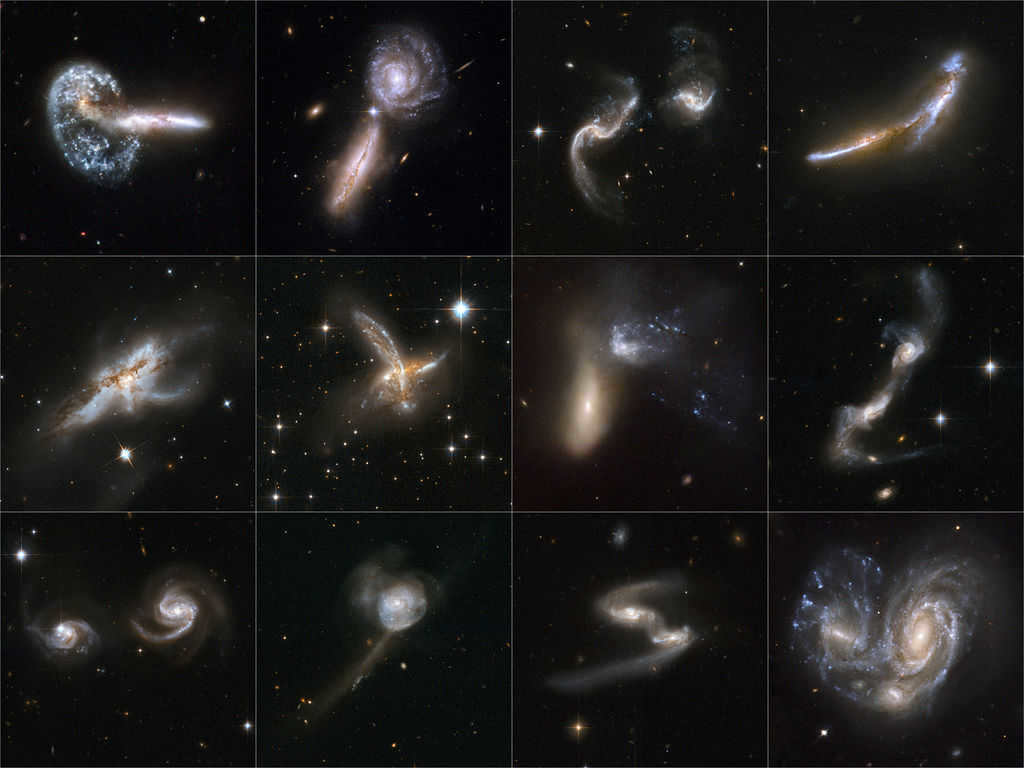
Galaxies: A World of Diversity
Galaxies come in a wide range of appearances and structures, leading to the classification of different morphological types.
Among the galaxies that are closest to us and brightest in the night sky, we find the Magellanic Clouds. As we explore the cosmos using advanced telescopes, we have discovered many galaxies that bear a resemblance to the Magellanic Clouds. These galaxies are known for their irregular and ethereal shape. Additionally, they contain a significant amount of gas, accounting for up to 50% of their total mass. This particular type of galaxy is classified as irregular galaxies and is labeled as Ir irregular.
Elliptical galaxies are typically identified by the letter E (from elliptical) followed by a number ranging from 0 to 6, which represents the level of compression of the system (E0 – “compact” galaxies, E6 – the most “compressed”). The reddish hue of elliptical galaxies can be attributed to their composition, which is primarily composed of aging stars. Cold gas is scarce in these systems, although the most massive ones contain highly rarefied hot gas with temperatures exceeding one million degrees.
Spiral galaxies display a distinctive spiral pattern consisting of two or more branches, or arms, that twist in one direction and extend from the center of the galaxy onto the galactic disk. This pattern is clearly visible against the backdrop of the galaxy’s halo, a sparsely populated cloud of faintly luminous stars. These types of galaxies are designated with the letter S. They are further classified based on the degree of structure and overall shape of their spiral branches, following the system developed by American astronomer Edwin Hubble. Galaxies with tightly twisted and smooth spiral branches are categorized as Sa type, characterized by a bright and elongated central bulge and indistinct, blurry arms. On the other hand, galaxies that exhibit more pronounced and well-defined spirals, with a less prominent central bulge, are classified as Sb type. Finally, galaxies with a wispy spiral structure and a less visible bulge against the overall background are classified as Sc type.
There are spiral systems that feature a stellar bar in the central region which is nearly straight.
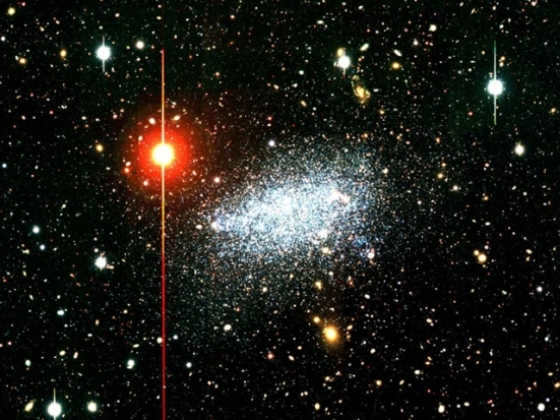
Leo A, a type of galaxy known as a dwarf irregular galaxy, is highly abundant in the Universe and may serve as the fundamental components for the formation of larger, more massive galaxies.
NGC 205 belongs to the category of dwarf elliptical galaxies and is one of the satellites orbiting the Andromeda Galaxy.
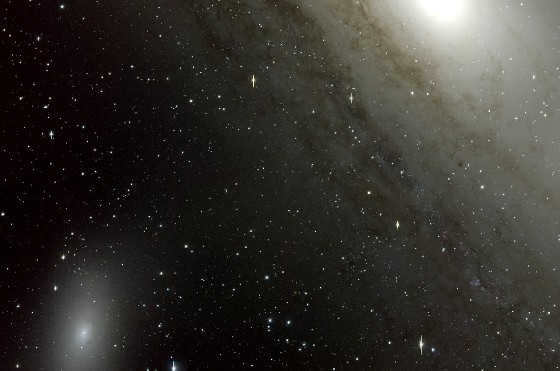
When it comes to this situation, their designation is modified by adding a B after the letter S (e.g. SBc).
Intermediate types of galaxies, known as lenticular galaxies, lie between spiral and elliptical galaxies. They possess a bulge, halo, and disk, but lack spiral arms. These galaxies are classified as SO.
There are also galaxies that are classified as dwarf galaxies. These dwarf galaxies do not fit into the classification system established by Hubble. The unique life journey of these stellar systems leaves its mark on the characteristics of the stars within the galaxies, as well as on the galaxies themselves. The exploration of the family of dwarf galaxies began in the 1930s. During this time, an American astronomer named Harlow Shapley stumbled upon two faint clusters of stars in the constellations of Sculptor and Furnace. It was unclear what these clusters were until their distances were measured. It was discovered that these faint star clusters were actually extragalactic objects – independent dwarf systems with extremely low density. This sparked interest in faint galaxies with low surface brightness, and soon many dwarf galaxies were identified. Dwarf galaxies are designated by the letter d (dwarf). They can be further classified into different types, such as dwarf elliptical (dE), dwarf spheroidal (dSph), dwarf irregular (dIr), and dwarf blue compact galaxies (dBCG, where BCG stands for blue compact galaxies).
Dwarf galaxies differ from typical elliptical galaxies primarily in their size and mass. Essentially, they are elliptical galaxies that have fewer stars. Dwarf galaxies are composed mostly of old, low-mass stars and have very little gas and dust. On the other hand, dwarf spheroidal galaxies are similar to dwarf elliptical galaxies but are much less dense. They are made up of elderly hydrogen-helium stars with a minimal amount of heavy chemical elements. This characteristic has a significant impact on the physical properties of these stars: they are hotter, bluer, and undergo a slightly different evolution compared to stars with a “solar” chemical composition.
Dwarf galaxies can be classified into different types, including dIr and dBCG. These galaxies are relatively small in size and mass and have an irregular shape. However, they are rich in gas. The main distinction between dIr and dBCG is that dBCG galaxies often experience intense star formation and generate a large number of blue massive stars. As a result, these galaxies appear brighter, more compact, and have a bluish hue. It is worth noting that dwarf galaxies lack well-developed spiral branches, which suggests that the formation of spirals requires a massive stellar disk.
Another type of galaxy is known as anemic or low brightness spiral galaxies. These galaxies belong to the class of large spiral star systems but have a much lower surface brightness compared to normal ones. What sets them apart is the low density of the stellar disk.
The various components of a galaxy, such as the bulge, disk, and halo, interact with each other through gravitational forces to create a cohesive whole. Currently, galaxies are in the process of self-formation, with the birth of stars and star clusters being a key factor. This process relies on the availability of gas as a source of “food”. Elliptical galaxies, having depleted their gas supply long ago, no longer contain young stars. However, in other galaxies where gas is still present, the formation of stars continues. This phenomenon occurs in large clusters, with star formation spanning vast regions measuring thousands of light-years. As the most massive stars reach the end of their lifespan, they explode as supernovae. These explosions create powerful shockwaves in the surrounding interstellar medium, triggering a “wave” of star formation in nearby areas of the galaxy.
The social status of a galaxy is determined by its mass. Massive, large galaxies are accompanied by a substantial retinue of smaller galaxies. On occasion, small galaxies may “offer tribute” as they pass through larger galaxies, relinquishing some or all of their building materials – gas. When two galaxies come close enough to one another, their gravitational fields actively impact the movement of stars and gas within these systems. Consequently, the appearance of galaxies can experience discernible alterations.
Spiral galaxies: a unique phenomenon in the universe
In 1845, Lord Ross (William Parsons), an astronomer from England, made a groundbreaking discovery using a telescope equipped with a 180-centimeter metal mirror. He identified a unique category of astronomical objects called “spiral nebulae”, with one of the most notable examples being a nebula located in the constellation of Canes Venatici (also known as M 51 in the Messier catalog). However, it was not until the first half of the 20th century that scientists were able to fully understand the nature of these nebulae. During this time, extensive research was conducted to determine the size of our own galaxy, the Milky Way, as well as the distances to certain nebulae that were found to be composed of individual stars. The findings from these studies were initially conflicting, with discrepancies in distance estimations and scale measurements. However, everything began to fall into place in the 1920s when cepheids, a type of variable star, were discovered in nearby spiral nebulae. This breakthrough allowed astronomers to accurately estimate the distances to these celestial objects. As early as 1908, Henrietta Livitt, an astronomer from the Harvard Observatory, identified a correlation between the period of luminosity change in cepheid variable stars and their actual luminosity. This correlation enabled scientists to determine the luminosity of a star based on its period, and subsequently, the distance to the star and the entire stellar system it belonged to. Using this method, researchers were able to calculate that the Andromeda Nebula is located approximately 900,000 light years away. However, this estimate turned out to be an underestimation, providing further evidence that spiral nebulae are massive star systems.
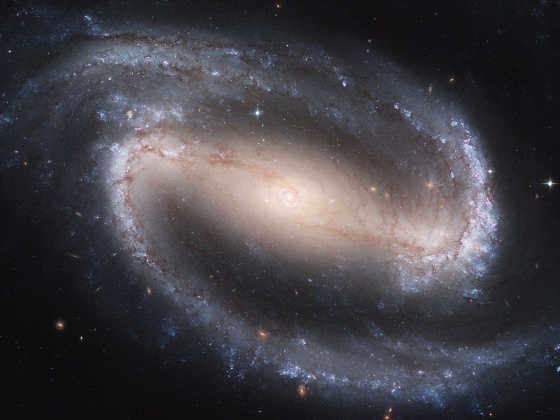
The magnificent spiral galaxy NGC 1300 is located in the Eridanus constellation, approximately 70 million light-years away. It spans an impressive distance of over 100 thousand light years.
M66, the spiral galaxy depicted in the image, is also 100 thousand light-years in size and lies at a distance of 35 million light-years from our Sun. It is the largest galaxy within the Leo triplet.
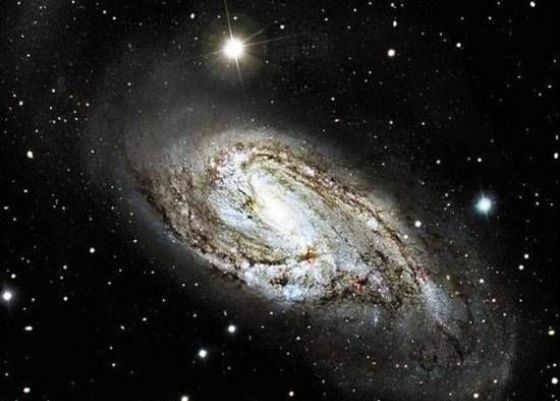
Galaxies similar to our own have been given the name “galaxies” ever since they were first discovered.
Spiral galaxies have a flat, disk-like shape, which is a result of their rotation. When galaxies form, the centrifugal forces prevent the protogalactic cloud or system of gas clouds from compressing in a direction perpendicular to the axis of rotation. As a result, the gas concentrates in a certain plane, giving rise to the rotating disks that we see in spiral galaxies. However, the disk does not rotate as a single solid body, like a wheel. The rotation period of stars at the edges of the disk is much longer than in the inner parts.
Astronomers put in a great deal of effort to comprehend the cause of other observed characteristics of spiral galaxies. Domestic science has made a significant contribution to the exploration of their essence. This is the current understanding of the structure of spiral arms within galaxies. All the stars residing in a galaxy engage in gravitational interactions, which leads to the formation of a shared gravitational field for the entire galaxy.
There are multiple identifiable factors that contribute to the formation of regular compactifications of matter that propagate in a wave-like manner on the surface of water when a massive disk rotates. In the context of galaxies, these compactifications take the form of spirals, which can be attributed to the nature of the disk’s rotation. Within the spiral branches, there is an observable increase in the density of both stars and interstellar matter, including dust and gas. The heightened density of gas serves to expedite the formation and subsequent compression of gas clouds, consequently facilitating the birth of new stars. As a result, the spiral branches serve as a hub for vigorous star formation.
Density waves known as spiral branches can be found on a rotating disk. As time passes, stars that are born within a spiral eventually move outside of it. The most massive and brightest stars have very short lifetimes, burning out before they can exit the spiral branch. On the other hand, less massive stars have longer lifetimes and spend their lives in the spaces between spirals on the disk. The bulge, which is a spherical concentration of yellow and red low-mass stars at the center of the galaxy, is much older than the stars found in the spiral branches. These stars were formed prior to the formation of the galactic disk. Originating in the center of the protogalactic cloud, they were no longer involved in the compression process that formed the galaxy plane, resulting in their spherical structure.
Let’s examine spiral galaxies using the case of M 51, also known as Whirlpool. In this specific galaxy, there exists a diminutive companion galaxy located at the extremity of one of its spiral arms. This satellite galaxy revolves around its parent galaxy. We have successfully constructed a computerized model to illustrate the development of this celestial system. According to this model, it is postulated that the proximity of the small galaxy to the large one induces significant gravitational disturbances within the latter’s disk. Consequently, a spiral-shaped density wave forms within the disk of the larger galaxy. The birth of stars within these spiral arms contributes to the distinct brightness of these branches.
The galaxy’s bulge and disk are surrounded by a substantial halo. Certain scientists propose that the primary mass of the halo is not in the form of stars, but rather in non-luminous (concealed) matter. This matter could consist of either intermediate-mass bodies, falling between the masses of stars and planets, or elementary particles that theorists predict exist but have not yet been found. The enigma of this concealed mass, known as hidden matter, is currently a topic of great interest among numerous scientists. Solving it could potentially provide insights into the nature of matter throughout the entire universe.
Galaxies Hosting Energetic Nuclei
Within the vast majority of galaxies, there exists a prominent central region known as the nucleus. In typical galaxies like our own, the heightened luminosity of the nucleus can be attributed to the dense concentration of stars. However, the overall number of stars within the nucleus is merely a small fraction of the total stellar population within the galaxy.
There exist certain galaxies that possess exceptionally radiant nuclei. In addition to stars, these nuclei harbor a brilliant, star-like source at their core, as well as luminous gas that moves at staggering velocities of thousands of kilometers per second. First identified by the American astronomer Carl Seyfert in 1943, these galaxies were later designated as Seyfert galaxies. Presently, thousands of such entities have been discovered. Seyfert galaxies, often referred to as seyferts, represent colossal galactic structures.
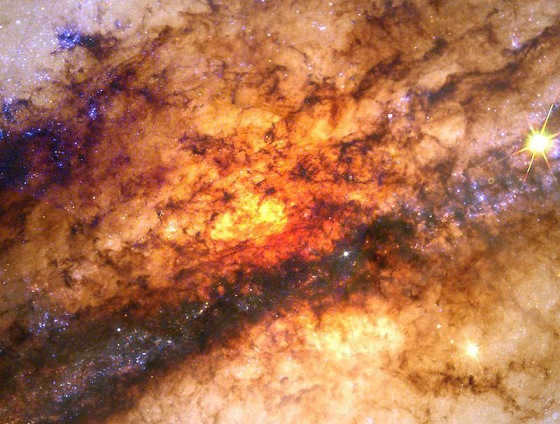
Centaurus A, an active galaxy, features a complex network of youthful blue star clusters, immense luminous gas clouds, and concealed dark dust veins at its core.
An artist’s representation showcases the presence of jets around a colossal black hole accompanied by an accretion disk. The jets are composed of matter.
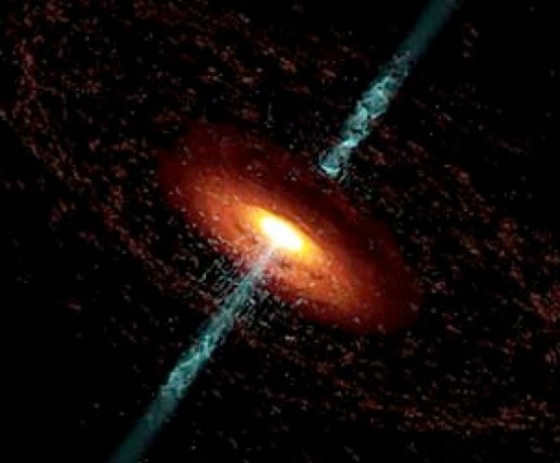
There has been an increase in the number of spiral star systems, including a higher proportion of barred galaxies (known as SB). Seyferts, which are galaxies with active nuclei, are more likely to form pairs or groups compared to ordinary galaxies, but they tend to avoid large clusters. While Seifert initially discovered 12 galaxies with active nuclei, these galaxies were not extensively studied for a period of 15 years. It was not until 1958 when Soviet astrophysicist Viktor Amazaspovich Ambartsumyan brought attention to these galaxies in the field of astronomy.
The manifestations of nuclear activity vary across different galaxies. They can exhibit a significant release of radiation in the optical, X-ray, or infrared regions of the spectrum, which can change noticeably over the course of several years, months, or even days. In certain instances, there is an exceptionally swift movement of gas in the central region, reaching speeds of thousands of kilometers per second. Occasionally, the gas takes on the form of elongated straight bursts. In certain galaxies, the nuclei serve as sources of high-energy elementary particles. These streams of particles often depart from the galaxy permanently in the form of radio emissions, or radio jets. Active nuclei of any kind are distinguished by an extremely high luminosity across the entire electromagnetic spectrum. The radiative power of Seyfert galaxies can sometimes reach 10^35 W, which is not much lower than the luminosity of our entire galaxy. However, this immense energy is emitted within a region with a diameter of approximately 1 pc – less than the distance from the Sun to the nearest star! The power of light emission, or optical luminosity, is considerably lower. Most of the energy is typically emitted within the infrared range.
What is the origin of the energy for such intense activity? What kind of compact “reactor” generates such a significant amount of energy? The ultimate answer is still unknown, but through the extensive work of theorists and observers, several plausible models have been developed. The initial hypothesis suggests the existence of a dense cluster of young stars at the center of the galaxy. Supernova explosions would occur frequently within this cluster, potentially explaining both the observed matter ejections from nuclei and the radiation variability. The second model, proposed in the late 1960s, draws upon the analogy of the then newly discovered pulsars. According to this version, the core activity originates from a supermassive star-like object with a powerful magnetic field known as a magnetoid. The third model revolves around the enigmatic black hole. It is theorized that there is a black hole with a mass of tens or hundreds of millions of solar masses at the galaxy’s core. Through matter accretion, an immense amount of energy is released. As matter falls into the black hole’s gravitational field, it accelerates to speeds close to that of light. Subsequently, when gas masses collide near the black hole, the kinetic energy is converted into the emission of electromagnetic waves.
Observations using the Hubble Space Telescope and other large ground-based telescopes have provided confirmation that there are significant amounts of non-luminous matter in the cores of several galaxies. This finding strongly supports the hypothesis that massive black holes are responsible for the activity observed in these cores. It is possible that black holes with masses exceeding one million times that of the sun are present in a significant portion of galaxies. There is also observational evidence supporting the existence of black holes in the cores of our own Milky Way galaxy and the Andromeda Nebula. However, due to their relatively small mass, the activity observed in these cores is relatively weak.
In many cases, these uncommon star systems belong to pairs or tight clusters, implying that all of these characteristics are a consequence of galaxies affecting one another. The renowned Soviet astronomer Boris Vorontsov-Veliaminov, who was the pioneer in researching such entities, referred to them as interacting galaxies. He has provided detailed descriptions and created catalogs for thousands of interacting systems, including those with the most unique structures and shapes.
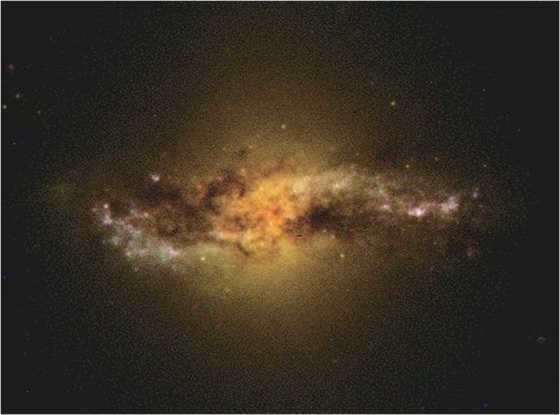
Research on Arp 230 has revealed that this seemingly isolated spiral galaxy is the outcome of a recent encounter between two spiral galaxies.
The formation of Centaurus A seems to have been triggered by the collision of two galaxies, with the remnants of this event still being consumed by a black hole.
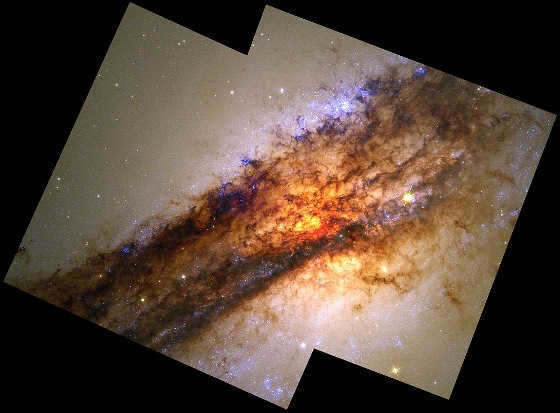
The interaction between galaxies is influenced by various factors, such as the presence of a stellar disk, the amount of interstellar gas, the distance, direction, and speed of the neighboring galaxy’s approach, as well as the orientation of its orbit. These factors contribute to the diverse shapes of interacting systems. However, a general prediction can be made: if galaxies form a system rather than randomly meeting in space, their interaction will eventually lead to close proximity and eventual merger. This process can take more than a billion years. Merging systems, which exhibit double or multiple nuclei, bright matter jets ejected into intergalactic space, or unusually long stellar “coronae,” have indeed been observed among known galaxies.
Galactic interaction goes beyond mere changes in structure or classification. Even galaxies that are relatively far apart can have a profound impact on each other, often resulting in a surge of star formation in one or both galaxies. The gravitational forces between interacting galaxies create ideal conditions for the formation of massive gas clouds. As these clouds continue to interact, their relative velocities increase, leading to more frequent collisions. These processes play a significant role in determining the rate of star formation. Additionally, a significant number of interacting galaxies also have active nuclei. According to current theories, the presence of an exceptionally dense object at the center of a galaxy, along with an abundant supply of gas, is necessary for the activation of the nucleus.
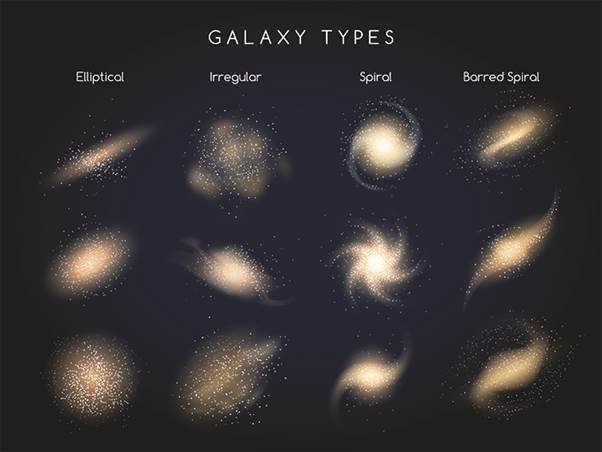

There are various hypotheses regarding the origin of galaxies. One hypothesis suggests that galaxies emerged from the aggregation of small groups called “globular clusters,” which consist of approximately a million stars.
Alternatively, another hypothesis proposes that galaxies formed prior to the clustering of stars.
Galaxy Classifications
Edwin P. Hubble developed a system for classifying galaxies, which was further refined by Gerard de Vaucouleur, another renowned astronomer.
There are three primary types of galaxies, with additional details based on characteristics such as band size and extent, spiral openness, and bulge size.
Further classifications were assigned based on the age spectrum of stars in the galaxies and their rates of star formation.
Spiral Galaxies
Spiral galaxies are the predominant type of galaxies in our Universe, characterized by their large rotating disks of nebulae and stars, surrounded by a halo of dark matter.
The central region of a spiral galaxy, known as the “galactic bulge,” is particularly bright and luminous. Additionally, many spiral galaxies possess star clusters and halos of stars both above and below their disks.
Among spiral galaxies, a significant majority are classified as “striped spirals,” distinguished by a prominent band or stripe of material and stars encircling their central sections.
In some cases, spiral galaxies also harbor supermassive black holes at their centers. Subgroups of spiral galaxies are further categorized based on the number and tightness of their spiral branches, as well as the size of their bulges.
Elliptical galaxies possess an oval or elliptical shape, which is often referred to as an egg shape. They mainly consist of small clusters and groups of galaxies and contain older, less massive stars.
Typically, elliptical galaxies have very limited star formation due to the absence of necessary dust clouds and gases. The number of stars in elliptical galaxies can vary greatly, ranging from a few hundred million to potentially a hundred trillion.
Furthermore, elliptical galaxies come in various sizes, ranging from a few thousand light-years wide to several hundred thousand light-years wide.
There are also subgroups of elliptical galaxies known as “dwarf ellipticals,” which exhibit characteristics that fall between globular clusters and standard ellipticals.
Irregular Galaxies
Irregular galaxies are a kind of temptation for those who lack a typical shape, as they are also irregularly formed.
The Small Magellanic Cloud is the prime example of an irregular galaxy visible in our night sky. They may possess a bar structure, contain regions for nurturing stars, and smaller ones are referred to as “dwarf irregulars.”
Irregular galaxies are defined by their lack of structure.
Galaxies: Single or Paired
Galaxies can exist either as single entities or in pairs. They are often part of larger formations, such as supergroups, clusters, or simply groups.
When in a group, galaxies interact with one another, sometimes even colliding and merging. These gravitational interactions can cause gases to move towards the galactic centers, leading to rapid star formation.
Our Milky Way Galaxy is currently on a collision course with the Andromeda Galaxy, located two million light-years away.
Scientists propose a theory suggesting that intergalactic interactions may be a natural phenomenon that transforms irregular galaxies into other types.
What is the total number of galaxies in existence?
The term “galaxy” is derived from the Greek word “galaxia”, meaning “milky”. As of now, we have observed a staggering 170 million galaxies.
Spiral galaxies, which harbor dense clouds of dust and hydrogen, are home to star nurseries located in their spiral arms.
The categorization of spiral galaxies according to the Hubble classification scheme begins with an “S” and is followed by an indication of the density of their spiral arms, represented by “a, b, or c”, as well as whether they are barred spirals denoted by “SB”.
Elliptical galaxies are believed to be older than spiral galaxies because spiral galaxies consume their dust and gas at a faster rate, eventually transforming into elliptical galaxies.
● Scientists believe that the first creation of galaxies was initiated by an event called the big bang.
● The three types of galaxies are spiral, elliptical, and irregular.
● Elliptical galaxies have a shape that can be described as oval or egg-shaped.
● The main identifying features of spiral galaxies are their arms.
● Scientists believe that each galaxy has a supermassive black hole at its center.
● Galaxies are not always alone in the universe, as they can exist in groups, clusters, or superclusters.
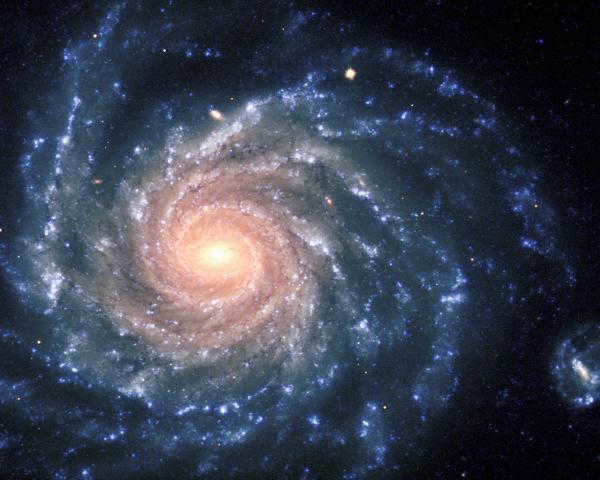
Classification of galaxies in the Universe
After conducting extensive research on nebulae, Hubble concluded that many of them share similarities with our own galaxy, the Milky Way. Drawing from the data he collected, Hubble categorized the various types of galaxies and similar celestial bodies that exist in the Universe. Additionally, he employed his findings to measure the distances to some of these galaxies, providing a framework that is still utilized by scientists today.
Hubble’s classification system divides the multitude of systems in the Universe into three main types: elliptical, spiral, and irregular galaxies. Each category is extensively studied by astronomers worldwide.
Our own galaxy, the Milky Way, is classified as a “spiral galaxy” and resides within a small portion of the Universe known as the Earth. The distinguishing characteristics of different types of galaxies are primarily determined by variations in their shapes, which in turn impact various properties of these celestial objects.
Spiral
Rephrase the text, making it unique, using the English language and preserving the HTML markup:
Spiral
Galactic types are not evenly dispersed throughout the vast expanse of the Universe. Based on current data, spiral-shaped galaxies are more prevalent compared to other forms. Alongside the Milky Way, this classification encompasses the Andromeda Nebula (M31) and the galaxy within the Triangle constellation (M33). These celestial entities possess a distinct and recognizable structure. When observed from an external perspective, their appearance from above resembles concentric circles radiating outward like ripples on water. The spiral arms emanate from a central spherical bulge, known as the balge. The number of these branches can vary from two to ten. Enveloping the entire disk with its spiral arms is a thin cloud of stars, referred to as the “halo” in astronomical terms. The galactic core consists of a cluster of luminous bodies.
Galaxy Subtypes
When it comes to astronomy, the designation S is used to classify spiral galaxies. These galaxies can be further categorized based on the structure of their arms and overall shape:
Sa galaxy: These galaxies feature tightly twisted and smooth arms, with a bright and extended bulge.
Sb galaxy: With strong and clear arms, Sb galaxies have a less pronounced bulge.
Sc galaxy: These galaxies have well-developed arms that present a wispy structure, with a poorly visible bulge.
Some spiral systems also have a central straight junction, known as a “bar”. In such cases, the galaxy designation includes the letter B (Sba or Sbc).
Galaxy Formation
The origin of spiral galaxies seems to resemble the ripple effect caused by a rock hitting the surface of water. Scientists believe that some kind of force is responsible for the formation of the spiral arms. These spiral arms can be thought of as waves of denser matter. The nature of this force can vary, with one possibility being movements within the central mass of stars.
The spiral arms consist of young stars and neutral gas, primarily composed of hydrogen. They are located within the galactic plane, giving the galaxy a flattened disk-like shape. The formation of young stars can also occur in the central region of these systems.
The closest neighbor
The Andromeda Nebula is classified as a spiral galaxy. When viewed from above, it exhibits multiple arms that extend from a central point. To the naked eye, it appears as a blurry and hazy patch in the night sky. The size of our neighboring galaxy is slightly larger than our own, measuring 130,000 light years in diameter.
In spite of being the closest galaxy to the Milky Way, the Andromeda Nebula is still incredibly distant. It takes light approximately two million years to traverse the vast expanse between the two galaxies. This fact underscores why the prospect of intergalactic travel remains confined to the realm of science fiction novels and movies.
Now let’s examine different kinds of galaxies. The photo of an elliptical system clearly illustrates its dissimilarity from its spiral counterpart. Instead of having arms, this type of galaxy appears as an elongated ellipse. These systems can be compressed to various degrees, resembling a lens or a sphere. They typically lack cold gas, but the most remarkable examples are filled with thinly spread hot gas, with temperatures surpassing a million degrees.
A notable characteristic of many elliptical galaxies is their reddish tint. For a while, astronomers believed this to indicate the age of such systems, assuming they primarily consist of aging stars. However, studies conducted in recent decades have disproven this presumption.
Education
For a significant period of time, there existed an alternative hypothesis pertaining to elliptical galaxies. It was believed that they were the earliest to emerge, coming into existence shortly after the occurrence of the Big Bang. Presently, this theory is considered outdated. German astronomers Alar and Yuri Tumre, along with South American scientist Francois Schweitzer, played a crucial role in disproving it. Their recent research and discoveries provide evidence supporting an alternative hypothesis, known as the hierarchical model of development. According to this model, larger structures were formed from relatively smaller ones, indicating that galaxies did not form instantaneously. Instead, their formation was preceded by the emergence of star clusters.
According to contemporary theories, elliptical systems are believed to originate from spiral systems when their arms merge. This is supported by the abundance of “twisted” galaxies observed in remote regions of the universe. In contrast, closer areas show a higher concentration of elliptical systems that are both bright and extensive.
Symbols
In the field of astronomy, elliptical galaxies have been assigned their own symbols. They are denoted by the symbol “E” followed by numbers ranging from 0 to 6, representing the level of flattening of the galaxy. E0 corresponds to galaxies that are nearly perfectly spherical, while E6 represents the most flattened ones.
Fierce cores
Elliptical galaxies, such as NGC 5128 in the Centaurus constellation and M87 in Virgo, are known for their powerful radio emissions. Astronomers are particularly interested in studying the central region of these galaxies. Russian scientists and observations made with the Hubble telescope have revealed a high level of activity in this area. In 1999, astrologers from South America obtained data on the core of NGC 5128, located in the Centaurus constellation. This region is characterized by the constant movement of large masses of hot gas, which may indicate the presence of a black hole. However, precise information about the nature of these processes is still unavailable.
Systems with unconventional shapes
The third type of galaxy exhibits an unstructured external appearance. These galaxies are characterized by their wispy and chaotic shapes. Irregular galaxies are less commonly found in the vastness of space compared to other types, but their study contributes to a deeper understanding of the processes occurring in the Universe. These galaxies are composed of up to 50% gas, making them unique in their composition. In the field of astronomy, these galaxies are designated with the symbol “Ir”.
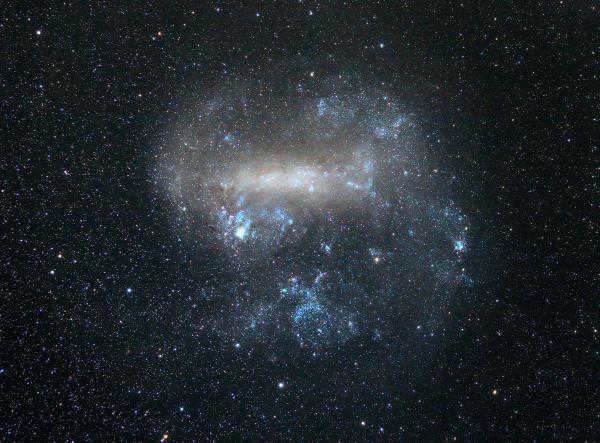
Irregularly shaped galaxies encompass the two closest systems to the Milky Way, namely its satellites: the Large and Small Magellanic Clouds. These celestial bodies are easily observable in the night sky of the southern hemisphere. The larger of the two galaxies is positioned approximately 200 thousand light years away from our location, while the smaller one is separated from the Milky Way by a distance of 170,000 light years.
Astronomers dedicate significant attention to studying the vastness of these systems, and the Magellanic Clouds provide ample reward for their efforts. Notably, the satellite galaxies often harbor remarkable objects. A notable event occurred on February 23, 1987, when a supernova erupted within the Large Magellanic Cloud. Additionally, the emission nebula Tarantula has sparked particular enthusiasm among researchers.
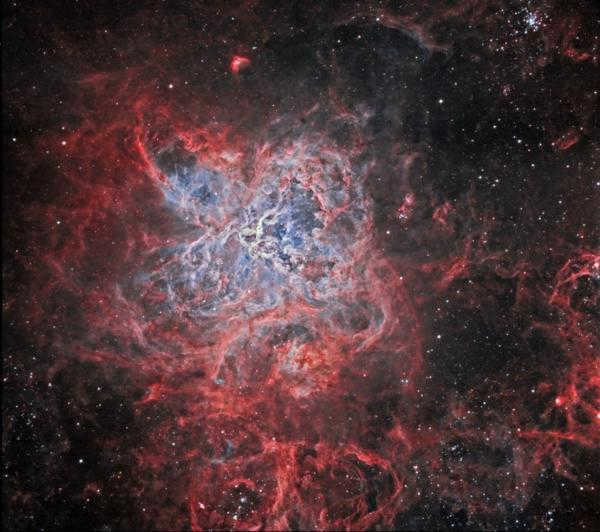
Furthermore, it is situated within the Large Magellanic Cloud. Scientists have made a remarkable finding of a region where stars are constantly being formed. Some of the celestial bodies that constitute the nebula are a mere two million years old. Additionally, this particular location is home to the most astonishing star that was discovered in 2011, RMC 136a1. It possesses a mass equivalent to 256 times that of the Sun.
Interacting Galaxies
The primary classifications of galaxies describe the specific characteristics of their shape and arrangement. However, the intriguing question of their interaction remains. It is well known that all celestial objects are in a perpetual state of motion, and galaxies are no exception. Some types of galaxies, or at least certain representatives of those types, may have been formed through the merging or colliding of two separate systems.
Understanding the nature of these interactions sheds light on how large-scale configurations can arise. When galaxies collide, an enormous amount of energy is released. Interestingly, such events are even more common in the vastness of space than the meeting of two stars.
Nevertheless, the interaction between galaxies does not always result in a collision and subsequent explosion. Sometimes, a smaller system can pass through a larger one, causing disruptions to its structure. This process can give rise to formations that bear a resemblance to elongated corridors. These corridors are composed of stars and gas, and often serve as regions where new celestial bodies are formed. Scientists are familiar with various examples of such systems, one of which is the Cartwheel galaxy located in the Sculptor constellation.
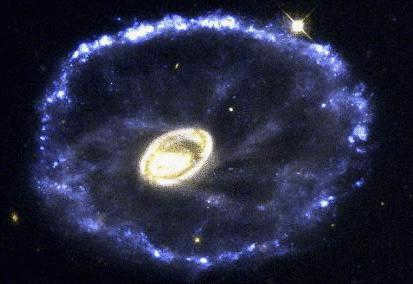
In certain scenarios, systems do not collide but rather pass by each other or have minimal contact. Nevertheless, regardless of the level of interaction, it results in significant alterations to the structure of both galaxies.
What lies ahead
Scientists hypothesize that at some point in the distant future, the Milky Way may assimilate its nearest companions, including a relatively recently discovered small system in cosmic terms, situated approximately 50 light years away from us. Research findings indicate a remarkable lifespan for this satellite, which will likely culminate in a fusion with its larger counterpart.
The Milky Way and the Andromeda Nebula are on a collision course in the foreseeable future. Currently, the vast neighboring galaxy is situated approximately 2.9 million light-years away from us. The two galaxies are gradually converging at a velocity of 300 kilometers per second. According to scientific estimations, this potential collision is projected to occur in approximately three billion years. However, it remains uncertain whether the collision will indeed transpire or if the galaxies will merely graze each other. The lack of comprehensive data regarding the movement characteristics of both entities complicates accurate prediction.
Modern astronomy is focused on studying various aspects of galaxies, such as their types, interactions, similarities, and differences, as well as their future. However, there are still many unknowns in this field that require further research. While we know the different types of galaxy structures, there is still much to learn about their formation and other details. Fortunately, with the constant advancements in technology and our understanding, we can expect significant breakthroughs in the future. Regardless, galaxies will continue to be a central focus of research, driven not only by curiosity but also by the desire to understand the cosmic patterns and the future of our own Milky Way galaxy.
Stay updated by subscribing to the UFO WORLD telegram channel.

